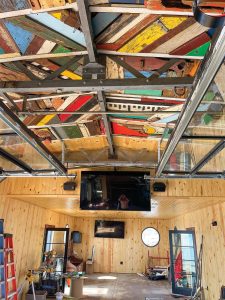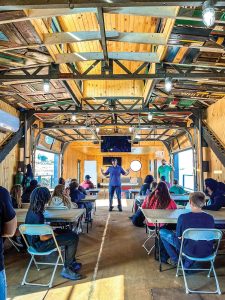Living Lands & Waters’ new educational barge has a history that goes back nearly a century.
The classroom, dubbed the Mississippi River Institute, is the shell of a 1930 steam-powered crane once used to lift wicket dams on the Ohio River. ARTCO’s Clinton, Iowa, shipyard cut the shell off at its base and then placed it onto a barge constructed a few years ago at Yager Marine in Owensboro, Ky., that was originally an excavator barge.
“I wanted a working structure, something that had a story of its own,” said Chad Pregracke, founder of Living Lands & Waters, a non-profit river cleanup organization established in 1998. “This thing just fit.”
While outfitted with new garage doors and windows, “every piece of painted wood we have been saving for the last 20 years or so” is on the ceiling, including water skis, he said. Old tractor cab cutouts are used as siding.
Roughly 11,000 students and teachers have visited Living Lands and Waters’ original classroom barge over the past 15 years.
Pregracke said the new barge will allow space for up to 40 people, along with a small kitchen.

It also includes an area for three, 14-passenger, non-tippable canoes that access the water via a built-in ramp, allowing students to have an on-the-water experience as part of the curriculum.
“That’s part of our day out there,” Pregracke said. “We want them to be inspired. We want them on the water.”
The classroom is designed to stay in a community for several weeks or even an entire semester and will focus specifically on maritime careers, with content geared toward juniors and seniors in high school. There will also be opportunities to use the space for after-school programs and community events, he said.
While currently in East Moline, Ill., Pregracke said the classroom barge will move to the St. Louis, Mo., area next summer with plans for student workshops four or five days a week beginning in fall 2024.
Pregracke said he wants to include visits for students who might sometimes have fewer opportunities to take educational field trips, even if that means providing financial assistance for them to do so.
Sponsors for the program include Cargill, ADM/ARTCO, Eckstein Charitable Trust, Ingram Barge Company, American Commercial Barge Line and Marquette Transportation, but Living Lands & Waters continues to look for more sponsors to increase the Mississippi River Institute’s availability.
Pregracke said he is excited to bring in his friend, television host and narrator Mike Rowe of “Dirty Jobs” fame, to provide the introduction and voiceover for a 12- to 15-minute video students will be shown about careers available on the river. Living Lands & Waters has spent the past two years working on the video. So far it highlights 26 different career opportunities, from iron workers to ornithologists and dredge operators to towboat pilots, marine architects and lobbyists.
Pregracke said it was important to include a diversity of people and career options. “I want to include a lot of people so they can see themselves being a part of it,” he said of students.
He also envisions students taking marine career aptitude tests, hearing from local speakers from within the industry and leaving with contact information for company recruiters in hand. Through the Mike Rowe Works program, scholarship opportunities will also be available for visiting students.
“On the other classroom we frame the river as a 2,300-mile corridor for wildlife,” Pregracke said. “On this classroom, we’re framing the river as 2,300 miles of opportunity.”

Living Lands & Waters is actively recruiting for a program coordinator to oversee and teach the curriculum. The organization is also building a list of potential speakers.
“The more people we can have with different perspectives and different career paths for the students, the more beneficial it will be for them,” Pregracke said.
Since launching the barge in October, Living Lands & Waters has held nine workshops on it so far.
“Seventeen different students signed up in the latest one,” Pregracke said. “A lot of them wanted to work in a shipyard. That was something they thought was really cool.”
Pregracke said part of the idea for the classroom barge was something LL&W Chairman Rick Calhoun said about the need to get youth “over the levee.”
“They need to see the river firsthand and see the opportunities and how they can relate to them,” Pregracke said. “People are disconnected from it. You can live a mile from it and not have any idea what exists out there.”
Pregracke said he wants the new educational program to shape lives and to remind students there is a fit for them somewhere in the industry, whether that’s through a college track or learning a trade.
He said, “I want them to leave inspired and know there’s some fit for them somewhere.”



